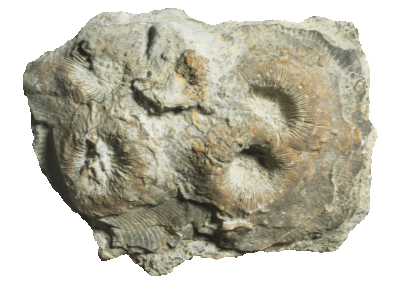October 2025: Wrinkled coral (Rugosa)
Schlotheimophyllum patellatum (Schlotheim, 1820)
SNSB-BSPG 2020 XCVII 5026
Silurian (lower Wenlock), ca. 427 million years, upper Visby Formation, Ireviken, Isle of Gotland, Baltic Sea, Schweden

The Swedish Baltic Sea island of Gotland offers a unique insight into the rock sequences of the Silurian period. A time span of approximately 10 million years (approx. 430–419 million years ago) is documented here in a marl-limestone sequence that has fascinated geologists and paleontologists from all over the world since the early 20th century and continues to inspire research. Of particular interest are the diverse reef structures, which are widespread at various stratigraphic levels. Today, they appear on the coasts as steep, massive limestone cliffs or in the form of bizarre limestone towers, known as raukars, carved out by wind, weather, and surf. Gotland’s fossil-rich sediments developed over 420 million years ago in a wide, subtropical, warm, shallow embayment off the southern coast of the ancient continent of Baltica.
The Silurian and Devonian periods are characterized by a worldwide distribution of tropical carbonate platforms, unparalleled in the last 540 million years of Earth’s history. Gigantic reef belts, even at higher latitudes, with lengths of over 1,000 km and deposits over 1,000 m thick are not uncommon. This geological time span is characterized by high sea levels and a warm greenhouse climate. Average temperatures were 10–15°C higher than those of our current interglacial period. The most important reef-building organisms were coralline sponges (stromatoporoids) and ancient corals (Tabulata, Rugosa), which partly formed species-rich communities in various reef structures (level bottom communities, biostromes, patch reefs, bioherms).
The Fossil of the Month, Schlotheimophyllum patellatum (Schlotheim, 1820), is a colonial rugose coral. Rugose corals, like modern-day stony corals (Scleractinia), belong to the hexacorals. Many hexacorals form a calcareous skeleton consisting of one (solitary) or several (colonial) coral calyces. This is a basal skeleton, above which the living tissue containing the coral polyp(s) rises during life. The skeleton consists of vertical and horizontal elements. The most striking vertical structures are the radially arranged, usually leaf-shaped septa. Horizontal structures include planar transverse elements or shovel- or rod-shaped elements in the rim region of the calyces.
The Rugosa became extinct approx. 250 million years ago during the great mass extinction at the end of the Permian period.
Schlotheimopyhllum pattelatum exhibits a highly variable growth form, ranging from disc-shaped to mushroom-shaped colonies. It is characterized by large coral cups with a deep central calyx and an adjacent, almost horizontal “platform.”
Martin Nose, Munich